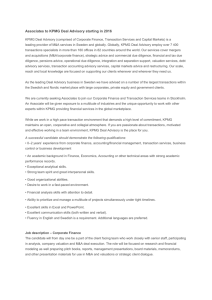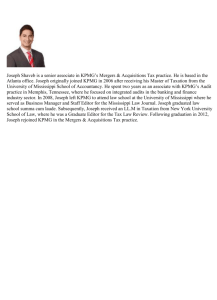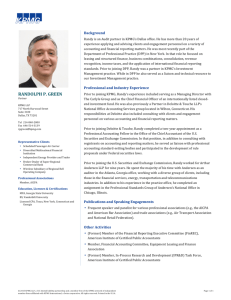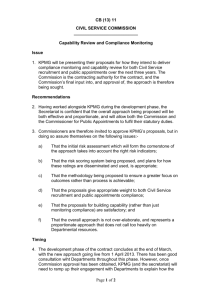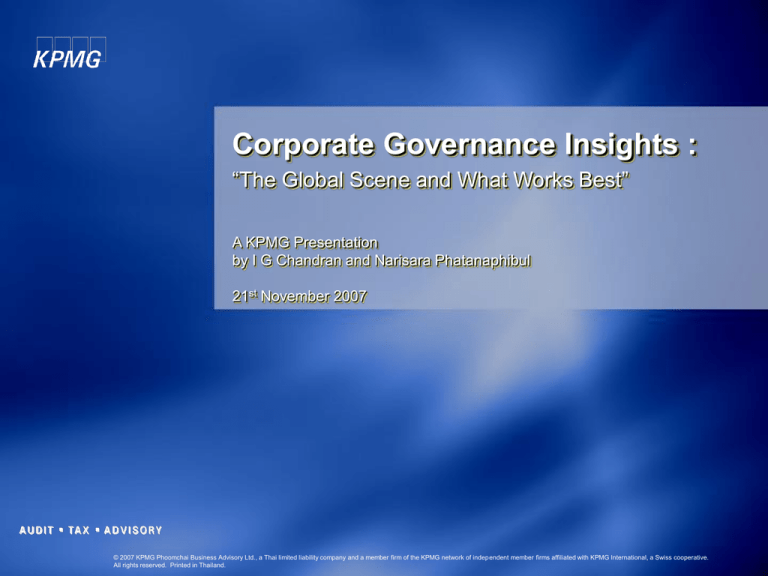
Corporate Governance Insights :
“The Global Scene and What Works Best”
A KPMG Presentation
by I G Chandran and Narisara Phatanaphibul
21st November 2007
©
KPMG
Phoomchai
Business Advisory
Ltd., a Thai
limited liability
andlimited
a memberliability
firm of thecompany
KPMG network
of independent
firmsthe
affiliated
with network
KPMG International,
a Swiss cooperative.
All rights
reserved.
Printed with
in Thailand.
©2007
2007
KPMG
Phoomchai
Business
Advisory
Ltd.,company
a Thai
and
a membermember
firm of
KPMG
of independent
member
firms
affiliated
KPMG International, a Swiss cooperative.
All rights reserved. Printed in Thailand.
1
Agenda
CG : International Reform – Issues and Insights
US & US Case studies – What went wrong?
The Thai Story on CG – Is it working?
The CG Healthcheck : “How do you stack up?"
© 2007 KPMG Phoomchai Business Advisory Ltd., a Thai limited liability company and a member firm of the KPMG network of independent member firms affiliated with KPMG International, a Swiss cooperative. All rights reserved. Printed in Thailand.
2
CG : International Reform
Issues and Insights
© 2007 KPMG Phoomchai Business Advisory Ltd., a Thai limited liability company and a member firm of the KPMG network of independent member firms affiliated with KPMG International, a Swiss cooperative. All rights reserved. Printed in Thailand.
3
Definition of corporate governance?
© 2007 KPMG Phoomchai Business Advisory Ltd., a Thai limited liability company and a member firm of the KPMG network of independent member firms affiliated with KPMG International, a Swiss cooperative. All rights reserved. Printed in Thailand.
4
One definition…
“A set of structure and process of relationships
between a company’s management, its board and its
shareholders to enhance its competitiveness towards
business prosperity and long term shareholders to
enhance its competitiveness towards business
prosperity and long term shareholder value by taking
into consideration the interests of others.”
Corporate Governance Guidelines 2006, the Stock Exchange of
Thailand
© 2007 KPMG Phoomchai Business Advisory Ltd., a Thai limited liability company and a member firm of the KPMG network of independent member firms affiliated with KPMG International, a Swiss cooperative. All rights reserved. Printed in Thailand.
5
…… and more definitions
“Process and structure used to direct and manage the
business and affairs of the company towards enhancing
business prosperity and corporate accountability with
the ultimate objective of realising long term shareholder
value, whilst taking into account the interests of other
stakeholders.”
Chapter 4, Report on Corporate Governance by the Finance
Committee on Corporate Governance (February 1999)
Malaysia
© 2007 KPMG Phoomchai Business Advisory Ltd., a Thai limited liability company and a member firm of the KPMG network of independent member firms affiliated with KPMG International, a Swiss cooperative. All rights reserved. Printed in Thailand.
6
…… and more definitions
“If management is about
running business,
governance is about
seeing that it runs
properly”
Professor Bob Tricker, 1984
© 2007 KPMG Phoomchai Business Advisory Ltd., a Thai limited liability company and a member firm of the KPMG network of independent member firms affiliated with KPMG International, a Swiss cooperative. All rights reserved. Printed in Thailand.
7
…… and more definitions
In essence, corporate
governance is the
“system by which
companies are directed
and controlled”
Sir Adrian Cadbury,
Cadbury Report, 1992
© 2007 KPMG Phoomchai Business Advisory Ltd., a Thai limited liability company and a member firm of the KPMG network of independent member firms affiliated with KPMG International, a Swiss cooperative. All rights reserved. Printed in Thailand.
8
What is “bad governance”?
“The business community now looks at
things in terms of what they can get away
with, not what is right”
Arthur Levitt - former SEC Chairman
© 2007 KPMG Phoomchai Business Advisory Ltd., a Thai limited liability company and a member firm of the KPMG network of independent member firms affiliated with KPMG International, a Swiss cooperative. All rights reserved. Printed in Thailand.
9
International governance reforms
United Kingdom
United States
1987 - Treadway Report: Report of the National
Committee on Fraudulent Financial Reporting
1992 - COSO Report: Internal Control Integrated Approach
1999 - Blue Ribbon Committee
2002 - Sarbanes-Oxley Act (SOX)
2003 - New NYSE and NASDAQ
Governance Listing Standards
1992 - Cadbury Report
1995 - Greenbury Report
1998 - Hampel Report
1998 - The Combined Code
1999 - Turnbull Report : Internal
Controls Guidance for Directors
2003 - Higgs and Smith Reports
2003 – Revised Combined Code
2005 – Proposed FSA Corporate Governance
Listing Rules
Developments
in Thailand
Corporate
Australia
1991 - Bosch Report
2003 - ASX Corporate
Governance Guidelines
© 2007 KPMG Phoomchai Business Advisory Ltd., a Thai limited liability company and a member firm of the KPMG network of independent member firms affiliated with KPMG International, a Swiss cooperative. All rights reserved. Printed in Thailand.
10
A Comparison of Selected Governance Practices
Practice
United States
United Kingdom
(Combined
Code)
Japan
(JCGC)
Thailand
Basic
Mix of mandated
and voluntary.
Comply or
explain.
Voluntary.
Voluntary.
Separation
of Chairman
& CEO
Traditionally not
separated –
trend towards
separation or
lead director.
Separated.
Traditionally not
separated.
Separated.
Independent
Board
Majority
Listing standards
require an
independent
majority.
At least half the
board, excluding
the chairman,
should comprise
non-executive
directors.
Recognizes that
a majority
should be
independent.
Number of
independent
directors should
be equivalent to
at last one-third
of Board size, but
not less than 3.
Source : Internal Auditor
© 2007 KPMG Phoomchai Business Advisory Ltd., a Thai limited liability company and a member firm of the KPMG network of independent member firms affiliated with KPMG International, a Swiss cooperative. All rights reserved. Printed in Thailand.
11
A Comparison of Selected Governance Practices
Practice
United States
Required
Board
Committees
Audit
committees
required by law.
Nominating and
compensation
committees
required by
NYSE listing
requirements,
but not by
NASD.
United Kingdom
(Combined
Code)
There should be
a nomination,
remuneration,
and audit
committee.
Japan
(JCGC)
Thailand
The board should
establish audit,
nomination, and
compensation
committees. The
board may
establish
litigation or other
committees for a
specific purpose.
Audit committees
required by the
SET listing rules.
There are two
recommended
committees
namely the
remuneration and
nomination
committees.
Source : Internal Auditor
© 2007 KPMG Phoomchai Business Advisory Ltd., a Thai limited liability company and a member firm of the KPMG network of independent member firms affiliated with KPMG International, a Swiss cooperative. All rights reserved. Printed in Thailand.
12
A Comparison of Selected Governance Practices
Practice
United States
Board
Access to
Independent
Advisors
Audit committee
authorised by law
to retain public
accountant and
advisors. NYSE
Listing standards
indicate that
nominating and
compensation
committee
charters should
give committees
sole authority to
retain search firms
and compensation
consultants,
respectively.
United Kingdom
(Combined
Code)
Non executive
directors have
access to
independent
professional
advice at the
company’s
expense where
they judge it
necessary.
Japan
(JCGC)
None other than
the outside
auditor specified.
Thailand
Not covered.
Source : Internal Auditor
© 2007 KPMG Phoomchai Business Advisory Ltd., a Thai limited liability company and a member firm of the KPMG network of independent member firms affiliated with KPMG International, a Swiss cooperative. All rights reserved. Printed in Thailand.
13
A Comparison of Selected Governance Practices
Practice
Auditor
Independence
United States
United
Kingdom
(Combined
Code)
Mandatory audit
partner rotation.
All audit and
non-audit
services of
registered
accountants
approved by
audit committee.
Non audit
services
restricted.
The audit
committee
reviews and
monitors auditor
independence
and non audit
services
supplied by the
outside auditor.
Japan
(JCGC)
Not covered.
Thailand
The audit
committee reviews
and monitors
auditor
independence and
non audit services
supplied by the
outside auditor.
Source : Internal Auditor
© 2007 KPMG Phoomchai Business Advisory Ltd., a Thai limited liability company and a member firm of the KPMG network of independent member firms affiliated with KPMG International, a Swiss cooperative. All rights reserved. Printed in Thailand.
14
Governance, risk and control
- An integrated model
Governance
Improving the effectiveness board operations and
performance through:
● Compliance with governance codes and applicable
laws and regulations
● Effectiveness and accountability of board of
directors
● Performance reviews and remuneration structures
An appropriate enterprise risk
management framework is in
place:
● which is aligned with
business strategy and
organisational risk appetite
and able to assess the
critical risks
Reporting
Corporate Functions
Strategy & Approach
● Improving management and
employee attitudes to risk
and risk taking to improve
decision making.
Control
Governance
Reporting
● Development of appropriate
reporting structures and
procedures for risk.
Board & Sub-Committees
Operating Units
Strategy & Approach
Risk
Assurance over risk
management and internal
control systems:
● The three lines of defence
against the risks are internal
audit; oversight functions;
and business operations
● Checks and balances aligned
with acceptable internal
control model such as COSO
framework
© 2007 KPMG Phoomchai Business Advisory Ltd., a Thai limited liability company and a member firm of the KPMG network of independent member firms affiliated with KPMG International, a Swiss cooperative. All rights reserved. Printed in Thailand.
15
CG and responsibilities of the Audit Committee
Shareholder
interest
Assessing risk & control
environment
Overseeing financial reporting
Evaluating the audit process
Control environment
Risk assessment
Control activities
Information & communication
Monitoring
Earnings releases
Financial statements
Committee diligence
Committee assessment
Internal audit role
External audit role
Independent audit expectations
Collaboration &
communication
Understanding results &
conclusion
© 2007 KPMG Phoomchai Business Advisory Ltd., a Thai limited liability company and a member firm of the KPMG network of independent member firms affiliated with KPMG International, a Swiss cooperative. All rights reserved. Printed in Thailand.
16
CG and Corporate social responsibility (CSR)
reporting
In today’s world, CSR, defined as “all aspects of business
behaviour and impact on society”, is on every corporate
agenda.
It embraces business practices, including
environmental management systems, human resources
policy and strategic investment for a sustainable future.
Behaving responsibility towards all stakeholders is likely to
engender trust, loyalty and motivation. This in turn,
creates value through, for example, improved productivity
and improved customer retention, reduced risk of litigation
and a stronger overall license to operate.
© 2007 KPMG Phoomchai Business Advisory Ltd., a Thai limited liability company and a member firm of the KPMG network of independent member firms affiliated with KPMG International, a Swiss cooperative. All rights reserved. Printed in Thailand.
17
What other companies are doing as responsible
corporate citizens?
British Petroleum
Royal Dutch/ Shell
Exxon Mobil
Business policies statement covering areas of ethical conduct, employees,
relationships, health, safety and environmental performance and control and
finance.
BP Sustainability Report, 2003
Publication of the Shell Report, 2003 issued on a yearly basis on
contributions made to sustainable development
Location Reports on sustainability issues in individual countries
Statement of General Business Principles covering areas including business
integrity, political activities, health, safety and the environment and the
community
Reporting on environmental performance in the annual Corporate Citizenship
Report, 2003
Standards of Business Conduct addressing amongst others ethical,
environmental, health and safety and customer relations and product quality
policies
© 2007 KPMG Phoomchai Business Advisory Ltd., a Thai limited liability company and a member firm of the KPMG network of independent member firms affiliated with KPMG International, a Swiss cooperative. All rights reserved. Printed in Thailand.
18
What other companies are doing as responsible
corporate citizens?
The Bangchak
Petroleum Public
Company Limited
(“BP”)
Business policies statement covering areas of code of conduct, employees,
safety and environmental performance and control, training, education and
finance.
PTT Exploration and
Production Public
Company Limited
(“PTTEP”)
Reporting on the Annual Report for year 2006
Business Conduct addressing amongst business integrity, quality, safety,
environment accomplishment and environmental responsibility in support
sustainable development.
The Siam Cement
Public Company
Limited (“SCG”)
Reporting on Principles of Good Corporate Governance covering areas of
Ethical management, Roles and Responsibilities of Stakeholders and Board
of Management, in the annual Report, 2006
Social Responsibilities covering areas of environment, health & safety,
public welfare and community developments, addressing on Sustainable
Report 2006
© 2007 KPMG Phoomchai Business Advisory Ltd., a Thai limited liability company and a member firm of the KPMG network of independent member firms affiliated with KPMG International, a Swiss cooperative. All rights reserved. Printed in Thailand.
19
Triple bottom line reporting in CSR
© 2007 KPMG Phoomchai Business Advisory Ltd., a Thai limited liability company and a member firm of the KPMG network of independent member firms affiliated with KPMG International, a Swiss cooperative. All rights reserved. Printed in Thailand.
20
Changing market focus
New regulations
Performance improvement
© 2007 KPMG Phoomchai Business Advisory Ltd., a Thai limited liability company and a member firm of the KPMG network of independent member firms affiliated with KPMG International, a Swiss cooperative. All rights reserved. Printed in Thailand.
21
Sustainable value and confidence
Sustainable
value and
confidence
Integrated risk
management
Improved
controls
Process transformation
Improved
processes
Compliance
Performance improvement
© 2007 KPMG Phoomchai Business Advisory Ltd., a Thai limited liability company and a member firm of the KPMG network of independent member firms affiliated with KPMG International, a Swiss cooperative. All rights reserved. Printed in Thailand.
22
Enterprise governance: Getting the balance right
Enterprise governance
Conformance Processes
Chairman/ CEO
Non Executive Directors
Audit Committee
Remuneration Committee
Risk Management
Internal Audit
Accountability
Assurance
Performance Processes
Strategic Planning and
Alignment
Strategic Decision Making
Strategic Risk Management
Scorecards
Strategic Enterprise
Systems
Continuous Improvement
Value Creation
Resource Utilisation
© 2007 KPMG Phoomchai Business Advisory Ltd., a Thai limited liability company and a member firm of the KPMG network of independent member firms affiliated with KPMG International, a Swiss cooperative. All rights reserved. Printed in Thailand.
23
Enterprise governance: 27 international case
studies from 10 countries
The case studies focused on: What went wrong in failure and
success, in the analysis of :
CORPORATE GOVERNANCE
STRATEGY
The principal 4 findings for CG:
The principal 4 findings of strategy:
Culture and tone at the top;
The chief executive;
The board of directors;
Internal controls.
(No single issue dominated)
Choice and clarity of strategy;
Strategy execution;
Ability to respond to abrupt changes;
Ability to undertake successful M&A.
(Unsuccessful M&A most significant issue)
CONCLUSION
Strategic oversight for which key priority areas are:
ERM
Acquisition process
Board performance
Source : International Federation of Accountants
© 2007 KPMG Phoomchai Business Advisory Ltd., a Thai limited liability company and a member firm of the KPMG network of independent member firms affiliated with KPMG International, a Swiss cooperative. All rights reserved. Printed in Thailand.
24
US & UK Case Studies
What went wrong?
© 2007 KPMG Phoomchai Business Advisory Ltd., a Thai limited liability company and a member firm of the KPMG network of independent member firms affiliated with KPMG International, a Swiss cooperative. All rights reserved. Printed in Thailand.
25
UK case studies- what went wrong?
Enron didn’t fail just because of improper accounting or alleged corruption at the top. It also
failed because of its entrepreneurial culture…The unrelenting emphasis on earnings growth
and individual initiative, coupled with a shocking absence of the usual corporate checks and
balances, tipped the culture from one that rewarded aggressive strategy to one that
increasingly relied on unethical corner-cutting.
In order to hit the 2000 year-end profit target, reserves were used to cover line charges. The
establishment of these reserves had been questionable at best, and the use of reserves to
cover current expenses was in clear violation of accounting rules. When mid-level
accounting personnel raised objections to this strategy , the CFO assured them that this was
a one- time event that would help WorldCom over a rough place in the road.
In 2002, frustrated by ExxonMobil's lack of disclosure on the risks and new business
opportunities
associated with climate change, shareholders representing over $55 billion
in ExxonMobil stock (20.3 percent of those voting) supported a resolution seeking greater
disclosure of the company's plans for renewable energy.
© 2007 KPMG Phoomchai Business Advisory Ltd., a Thai limited liability company and a member firm of the KPMG network of independent member firms affiliated with KPMG International, a Swiss cooperative. All rights reserved. Printed in Thailand.
26
UK case studies- what went wrong?
In the case of Marconi in the UK, the “ biggest failure was shareholders, non-executive
directors and the wider analytical community, including the press, failing to act as an
effective check and balance on managements that were under pressure to address
exceptionally difficult strategic problems”.
The board of Marks and Spencer in the UK was well aware that it needed to split the
roles of chairman and Chief Executive as recommended by UK corporate governance best
practice. However, there was no obvious candidate for the post of chief executive. At this
point, the board failed to ensure that appropriate steps were taken to groom an internal
executive or to search outside the company. The failure to act created boardroom coup
became inevitable.
Cable & Wireless duly sold its local access firms and invested the proceeds in long-haul
data capacity and related services for large companies. It bought an American network,
built a European one and beefed up its undersea cable network. The problem was that
many other firms were doing exactly the same thing, resulting in a capacity glut and
tumbling prices.
© 2007 KPMG Phoomchai Business Advisory Ltd., a Thai limited liability company and a member firm of the KPMG network of independent member firms affiliated with KPMG International, a Swiss cooperative. All rights reserved. Printed in Thailand.
27
Lessons learnt from the Enron….
Independence of board & committee members
Conflicts of interest
Board & management relationship
Executive & non-executive remuneration
Auditor independence
“The abrupt and dramatic transformation from a well-respected and
award winning company to a disgraced and bankrupt enterprise in
less than three months.”
The Permanent Subcommittee on Investigations, 2002
© 2007 KPMG Phoomchai Business Advisory Ltd., a Thai limited liability company and a member firm of the KPMG network of independent member firms affiliated with KPMG International, a Swiss cooperative. All rights reserved. Printed in Thailand.
28
However, corporate governance failures
continues
Nature of offence
Facts of the case
Accounting irregularities
Overstatement of oil and gas reserves by Shell. The company further
announced that the overstated reserves had exaggerated its profit by
$276 million and that this had been known by top executives for at
least two years. Shell has since overhaul its reserves practices and
review its corporate governance standards. Formal investigation has
been launched by the SEC on the irregularities (2004).
Brystol-Myers Squibb was fined $150 million by the SEC for inflating
sales by encouraging wholesalers to overstock its products and
recognizing $ 1.5 billion of revenue at the point of shipment (August
2004)
Former Chairman of Vivendi Universal was placed under formal
investigation for suspected financial wrongdoings. Allegations include
insider trading, share price manipulation, publication of misleading
information and misusing company’s funds (2004).
Executive compensation
Shareholder lawsuit was taken against the Board of Disney for the
severance package of $140 million paid to its former president Michael
Ovitz, who was ousted from Disney after just 14 months with the
company (2004).
© 2007 KPMG Phoomchai Business Advisory Ltd., a Thai limited liability company and a member firm of the KPMG network of independent member firms affiliated with KPMG International, a Swiss cooperative. All rights reserved. Printed in Thailand.
29
How is business responding?
Economist Intelligence Unit (EIU) survey of top 10 companies in UK,
US, Germany, France and Japan (August 2003) revealed:
76% included a separate section on corporate governance in 2003
Vs 68% in 2002 annual report;
With the exception of Japan most companies now provide clear
information on committees and supervisory boards responsible for
auditing and executive pay;
Good information on accounting policies and risks; and
US corporates in particular appear to have taken significant steps to
become more transparent
© 2007 KPMG Phoomchai Business Advisory Ltd., a Thai limited liability company and a member firm of the KPMG network of independent member firms affiliated with KPMG International, a Swiss cooperative. All rights reserved. Printed in Thailand.
30
How is business responding? (cont.)
How much of a priority is corporate governance?
Top Priority 8%
One of the top three priorities 32%
Among our top ten priorities 37%
Important but not a management priority 18%%
Not important 5%
From: EIU August 2003
© 2007 KPMG Phoomchai Business Advisory Ltd., a Thai limited liability company and a member firm of the KPMG network of independent member firms affiliated with KPMG International, a Swiss cooperative. All rights reserved. Printed in Thailand.
31
Summary of analysis on case studies: What
went wrong?
Company
Ethics/Culture/
Tone at the top
Chief Executive
Officer
Board of
Directors
Internal Control/
Compliance/ Risk
Management
Aggressive
Earnings
Management
Ahold (Netherlands)
Enron (US)
WorldCom (US)
Xerox (US)
Vivendi (France)
Cable & Wireless (UK)
D Tripcovich (Italy)
France Telecom (France)
Source : International Federation of Accountants,2003
= issue had relatively minor significance in the case study
= issue was of moderate significance
= issue was of major significance
© 2007 KPMG Phoomchai Business Advisory Ltd., a Thai limited liability company and a member firm of the KPMG network of independent member firms affiliated with KPMG International, a Swiss cooperative. All rights reserved. Printed in Thailand.
32
The Thai Story on CG
Is it working?
© 2007 KPMG Phoomchai Business Advisory Ltd., a Thai limited liability company and a member firm of the KPMG network of independent member firms affiliated with KPMG International, a Swiss cooperative. All rights reserved. Printed in Thailand.
33
Development of Corporate Governance in
Thailand
1994
2001
2002
2003
2006
SEC established committee for developing good corporate governance
PM’s Office released rules for good domestic affairs administration
SET’s 40 principles of corporate governance released
Named “Year of Good Corporate Governance”
SET’s 15 principles of corporate governance released
National Corporate Governance Committee and website established
Principles for good domestic affairs administration Decree
SEC’s Best Practice for Code of Conduct for Listed Companies
released and The Principles of Good Corporate Governance for Listed
Companies
© 2007 KPMG Phoomchai Business Advisory Ltd., a Thai limited liability company and a member firm of the KPMG network of independent member firms affiliated with KPMG International, a Swiss cooperative. All rights reserved. Printed in Thailand.
34
Principles of Corporate Governance Thailand
The Principles of Good Corporate Governance for Listed Companies,
are divided into two parts, the principles and the recommended best
practices. The principles cover all important issues concerning good
corporate governance whilst the content in the recommended best
practices offers supplementary descriptions or means to enable
companies to implement the principles.
THE PRINCIPLES STRUCTURE
Category I
Category II
Category III
Category IV
Category V
Rights of
Shareholders
Equitable
Treatment of
Shareholders
Role of
Stakeholders
Disclosure and
Transparency
Responsibilities
of the Board
© 2007 KPMG Phoomchai Business Advisory Ltd., a Thai limited liability company and a member firm of the KPMG network of independent member firms affiliated with KPMG International, a Swiss cooperative. All rights reserved. Printed in Thailand.
35
Principles of Corporate Governance –
Thailand (Cont.)
THE PRINCIPLES STRUCTURE
Category I
Rights of
Shareholders
The corporate governance framework
should protect and facilitate the exercise
of shareholders’ rights.
© 2007 KPMG Phoomchai Business Advisory Ltd., a Thai limited liability company and a member firm of the KPMG network of independent member firms affiliated with KPMG International, a Swiss cooperative. All rights reserved. Printed in Thailand.
36
Principles of Corporate Governance –
Thailand (Cont.)
THE PRINCIPLES STRUCTURE
Category II
Equitable
Treatment of
Shareholders
The corporate governance framework
should ensure the equitable treatment of all
shareholders, including minority and
foreign shareholders. All shareholders
should have the opportunity to obtain
effective redress for violation of their rights.
© 2007 KPMG Phoomchai Business Advisory Ltd., a Thai limited liability company and a member firm of the KPMG network of independent member firms affiliated with KPMG International, a Swiss cooperative. All rights reserved. Printed in Thailand.
37
Principles of Corporate Governance –
Thailand (Cont.)
THE PRINCIPLES STRUCTURE
Category III
Role of
Stakeholders
The corporate governance framework
should recognise the rights of stakeholders
established by law or through mutual
agreements and encourage active
cooperations and stakeholders creating
wealth, jobs, and the sustainability of
financially sound enterprises.
© 2007 KPMG Phoomchai Business Advisory Ltd., a Thai limited liability company and a member firm of the KPMG network of independent member firms affiliated with KPMG International, a Swiss cooperative. All rights reserved. Printed in Thailand.
38
Principles of Corporate Governance –
Thailand (Cont.)
THE PRINCIPLES STRUCTURE
Category IV
Disclosure
and
Transparency
The corporate governance framework
should ensure that timely and accurate
disclosure is made on all material matters
regarding the corporation, including the
financial situation, performance, ownership,
and governance of the company.
© 2007 KPMG Phoomchai Business Advisory Ltd., a Thai limited liability company and a member firm of the KPMG network of independent member firms affiliated with KPMG International, a Swiss cooperative. All rights reserved. Printed in Thailand.
39
Principles of Corporate Governance –
Thailand (Cont.)
THE PRINCIPLES STRUCTURE
Category V
Responsibilities
of the Board
The corporate governance framework
should ensure the strategic guidance of
the company, the effective monitoring of
management by the board, and the
board’s accountability to the company and
the shareholders.
© 2007 KPMG Phoomchai Business Advisory Ltd., a Thai limited liability company and a member firm of the KPMG network of independent member firms affiliated with KPMG International, a Swiss cooperative. All rights reserved. Printed in Thailand.
40
Principles of Corporate Governance –
Thailand (Cont.)
3. Roles and Responsibilities
of the Board
2. Committees
4. Board Meetings
Part V
Responsibilities of the Board
1. Board Structure
7. Board and Management
Training
5 .Board Self Assessment
6. Remuneration
© 2007 KPMG Phoomchai Business Advisory Ltd., a Thai limited liability company and a member firm of the KPMG network of independent member firms affiliated with KPMG International, a Swiss cooperative. All rights reserved. Printed in Thailand.
41
Principles of Corporate Governance –
Thailand (Cont.)
2. set and approve a
1. review and approve
key business matters
written corporate
governance policy
3. ensure that a written
code of business
conduct be in place
6. establish a risk
management policy to
cover all activities of the
company
4. consider any
5. ensure that internal control
system is in place, including
financial, compliance, and policy
control, and review the system
at least annually
conflict of interests
thoroughly
© 2007 KPMG Phoomchai Business Advisory Ltd., a Thai limited liability company and a member firm of the KPMG network of independent member firms affiliated with KPMG International, a Swiss cooperative. All rights reserved. Printed in Thailand.
42
Scoring Criteria for Corporate Governance
Report
Thai listed companies are evaluated according to 123
criteria in the following five categories derived from the
OECD principles of corporate governance:
The Rights of Shareholders
Equitable Treatment of Shareholders
The Role of Stakeholders in Corporate Governance
Disclosure and Transparency
Responsibilities of the Board
© 2007 KPMG Phoomchai Business Advisory Ltd., a Thai limited liability company and a member firm of the KPMG network of independent member firms affiliated with KPMG International, a Swiss cooperative. All rights reserved. Printed in Thailand.
43
Scoring Criteria for Corporate Governance
Report (Cont.)
Information Sources:
Company annual report
Annual information filing (Form 56-1)
Notice and minutes of companies’ shareholders meeting
Company website
Information on SET/SEC database
Other publicly available information
© 2007 KPMG Phoomchai Business Advisory Ltd., a Thai limited liability company and a member firm of the KPMG network of independent member firms affiliated with KPMG International, a Swiss cooperative. All rights reserved. Printed in Thailand.
44
Scoring Criteria for Corporate Governance
Report (Cont.)
© 2007 KPMG Phoomchai Business Advisory Ltd., a Thai limited liability company and a member firm of the KPMG network of independent member firms affiliated with KPMG International, a Swiss cooperative. All rights reserved. Printed in Thailand.
45
Scoring Criteria for Corporate Governance
Report (Cont.)
KTB
PTT
BANPU
SCB
CGR Excellent
BBL
RATCH
BCP
KBANK
PTTEP
© 2007 KPMG Phoomchai Business Advisory Ltd., a Thai limited liability company and a member firm of the KPMG network of independent member firms affiliated with KPMG International, a Swiss cooperative. All rights reserved. Printed in Thailand.
46
The CG Healthcheck
How do you stack up?
© 2007 KPMG Phoomchai Business Advisory Ltd., a Thai limited liability company and a member firm of the KPMG network of independent member firms affiliated with KPMG International, a Swiss cooperative. All rights reserved. Printed in Thailand.
47
Key messages – going forward…
Performance reviews
Training for directors
Communicating with
shareholders
Corporate Disclosure
© 2007 KPMG Phoomchai Business Advisory Ltd., a Thai limited liability company and a member firm of the KPMG network of independent member firms affiliated with KPMG International, a Swiss cooperative. All rights reserved. Printed in Thailand.
48
Selected Corporate Governance Best Practices
How does your company stack up against these selected best practices?
A “No” denotes additional risk for the CAE to consider.
Yes
1
Is a significant majority of the board composed of persons who are independent of management and
controlling shareholders?
2
Is the chairman or lead director of the board an independent outside director?
3
Is the board both functionally and technically balanced?
4
Is the size of the board appropriate for the size of the business and not unduly large?
5
Are auditing, compensation, and nomination/governance the province of independent directors, functioning
under their own charters? Do the independent directors regularly engage in self-evaluation?
6
Do the board and supporting committees have access to their own advisers and counsel as needed?
7
Are controls over financial reporting documented with the entire senior management team certifying the
financial results for individual businesses or divisions?
8
Do the directors, managers, and employees attest annually to a code of conduct? Are there regular efforts
to provide related training and to gauge the effectiveness of communications regarding corporate values?
9
Are there mechanisms for employees or vendors to report serious policy infractions or fraud independent
from management? Do whistleblower protections exist for those who avail themselves of these
mechanisms?
10
Is the chief audit executive retained through, evaluated, and compensated by the audit committee of the
board of directors?
No
Source : February 2005 Internal Auditor
© 2007 KPMG Phoomchai Business Advisory Ltd., a Thai limited liability company and a member firm of the KPMG network of independent member firms affiliated with KPMG International, a Swiss cooperative. All rights reserved. Printed in Thailand.
49
Red Flags of Weak Corporate Governance
There is no independent leader of the board, whether that leader has
the title of chairman, lead director, or presiding director.
There is a lack of open dialogue at board meetings.
The board does not retain its own outside experts for counsel on
important issues such as compensation, risk management, and
governance.
Meeting materials are not sent to directors sufficiently ahead of time to
assimilate.
Non executive directors are overly reliant on management for setting
meeting agendas.
The size of the board is overly large, retarding effective communication
among directors and independent consensus building.
Non executive director contact with line managers is not encouraged.
There are excessive anti-takeover provisions in place that
disadvantage active shareholders and unfairly protect management.
© 2007 KPMG Phoomchai Business Advisory Ltd., a Thai limited liability company and a member firm of the KPMG network of independent member firms affiliated with KPMG International, a Swiss cooperative. All rights reserved. Printed in Thailand.
50
Red Flags of Weak Corporate Governance
(Cont.)
The board does not consider shareholder proxy requests.
A significant number of directors are company executives, or persons
with business or personal relationships with the CEO or the company,
who could be expected to follow the lead of the CEO.
The board is dependent on management to identify and nominate new
directors.
There is little correlation between corporate performance and incentive
compensation.
The CEO and CFO promote a culture of aggressive growth and give
lip service to the importance of “tone at the top” such that aggressive
accounting policies and lack of accounting transparency is tolerated or
encouraged.
Mechanisms for reporting serious breaches of policy independent of
management and for protecting whistleblowers are not developed or
communicated effectively.
Source : February 2005 Internal Auditor
© 2007 KPMG Phoomchai Business Advisory Ltd., a Thai limited liability company and a member firm of the KPMG network of independent member firms affiliated with KPMG International, a Swiss cooperative. All rights reserved. Printed in Thailand.
51
The linkage between corporate
governance and shareholders value
Shareholder
Value
Shareholders
Communication
Impact Upon Performance
Performance linked
Corporate Governance Mechanisms
Accountability / Transparency
Effective Regulatory
Regime
© 2007 KPMG Phoomchai Business Advisory Ltd., a Thai limited liability company and a member firm of the KPMG network of independent member firms affiliated with KPMG International, a Swiss cooperative. All rights reserved. Printed in Thailand.
52
Some questions to ponder
Is the board making a strategic impact on
the Group?
© 2007 KPMG Phoomchai Business Advisory Ltd., a Thai limited liability company and a member firm of the KPMG network of independent member firms affiliated with KPMG International, a Swiss cooperative. All rights reserved. Printed in Thailand.
53
Some questions to ponder
Does the board have a good handle on the
Group risks?
Are Group values and ethical standards
effectively guiding business decisions and
behaviors?
© 2007 KPMG Phoomchai Business Advisory Ltd., a Thai limited liability company and a member firm of the KPMG network of independent member firms affiliated with KPMG International, a Swiss cooperative. All rights reserved. Printed in Thailand.
54
Some questions to ponder
Does the board’s stewardship provide
for transparency, accountability and
responsiveness to the Group
stakeholder concerns?
© 2007 KPMG Phoomchai Business Advisory Ltd., a Thai limited liability company and a member firm of the KPMG network of independent member firms affiliated with KPMG International, a Swiss cooperative. All rights reserved. Printed in Thailand.
55
Does corporate governance matter?
The way forward
Most investors said that a well governed company would earn a premium
on their share price of between 11-38% (Malaysia: 22%)
© 2007 KPMG Phoomchai Business Advisory Ltd., a Thai limited liability company and a member firm of the KPMG network of independent member firms affiliated with KPMG International, a Swiss cooperative. All rights reserved. Printed in Thailand.
56
The last word on CG……
“ For me, the key to good corporate governance lies in
substance, not form. It is about the way the directors of
a company create and develop a model to fit the
circumstances of that company and then test it
periodically for its practical effectiveness”
“One thing is clear though. Whatever the model, the
public must know about it and how it is operating in
practice. Disclosure should be a central feature of any
corporate governance regime”
Justice Owen, HIH Royal Commission
© 2007 KPMG Phoomchai Business Advisory Ltd., a Thai limited liability company and a member firm of the KPMG network of independent member firms affiliated with KPMG International, a Swiss cooperative. All rights reserved. Printed in Thailand.
57
Presenter’s contact details
I G Chandran
Partner in Charge, Advisory
Narisara Phatanaphibul
Partner, Advisory
KPMG Phoomchai Business
Advisory Ltd.
KPMG Phoomchai Business
Advisory Ltd.
Tel : +66 2677 2713
Fax : +66 2677 2222
Igchandran-bkk@kpmg.co.th
Tel : +66 2677 2786
Fax : +66 2677 2222
narisara@kpmg.co.th
The information contained herein presentation is of a general nature and is not intended to address the circumstances of any particular individual or entity. Although
we endeavor to provide accurate and timely information, there can be no guarantee that such information is accurate as of the date it is received or that it will
continue to be accurate in the future. No one should act on such information without appropriate professional advice after a thorough examination of the particular
situation.
© 2007 KPMG Phoomchai Business Advisory Ltd., a Thai limited liability company and a member firm of the KPMG network of independent member firms affiliated with KPMG International, a Swiss cooperative. All rights reserved. Printed in Thailand.
58


